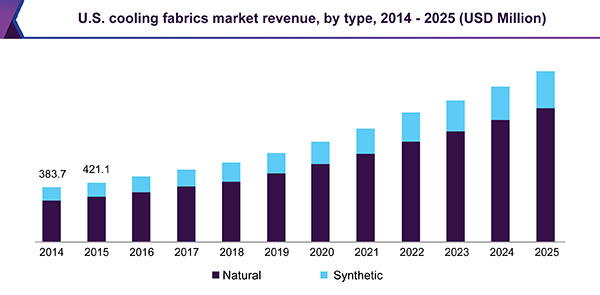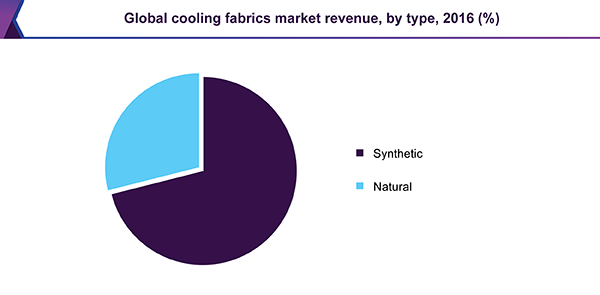- Home
- »
- Smart Textiles
- »
-
Cooling Fabrics Market Size, Share, Global Industry Report, 2018-2025GVR Report cover
![Cooling Fabrics Market Size, Share & Trends Report]()
Cooling Fabrics Market Size, Share & Trends Analysis Report By Type (Synthetic and Natural), By Application (Sports Apparel, Protective Wear, Lifestyle), By Region, And Segment Forecasts, 2018 - 2025
- Report ID: GVR-2-68038-007-1
- Number of Report Pages: 130
- Format: PDF, Horizon Databook
- Historical Range: 2014 - 2015
- Forecast Period: 2017 - 2025
- Industry: Advanced Materials
Report Overview
The global cooling fabrics market size was valued at USD 1.25 billion in 2016 and is projected to record a CAGR of 11.1% over the forecast period. The global technological advancements coupled with rising awareness regarding cooling fabrics among consumers are the factors likely to boost the market growth in the coming years. Changing consumer trends and preferences along with increasing research and development activities are expected to drive cooling fabrics growth over the forecast period.

The product demand is witnessing growth as it is evolving as a smart and intelligent fabric for garments, which helps keep the wearer’s body cool, evaporates sweat, and provides protection against heat stress. The growing popularity of cooling fabrics, considering their inherent distinct advantages, is likely to propel market demand over the next eight years. Rising sports and leisure activities in regions such as North America, Europe, and the Asia Pacific are anticipated to positively impact the market.
Synthetic cooling fabrics currently dominate the market and the trend is expected to continue over the forecast period owing to their benefits such as enhanced cooling and moisture management in comparison to other garments. Properties of the fabric such as higher strength and durability have widened its potential scope of use in various applications. The segment is expected to account for a significant market share over the forecast period.
Key attributes of cooling fabrics, such as temperature regulation, wrinkle-free texture, moisture-wicking, and quick-drying, are projected to fuel market growth. Major players in the industry are constantly striving toward technological advancements in an attempt to manufacture quality products and increase efficiency. Increasing the use of cooling garments for sports and fitness activities is further anticipated to boost its demand.
However, high prices of cooling fabrics make them unaffordable for a majority of the middle-class segment. High prices can be attributed to the extensive research and development along with the use of high-end materials, such as nanomaterials and nanoporous polyethylene, for manufacturing cooling garments. A low level of awareness among the consumers regarding cooling fabrics is also expected to pose a challenge to market growth. Additionally, manufacturers are required to conform to numerous standards and regulations set by authorities in different regions.
Type Insights
Some examples of synthetic fabrics are polyester, nylon, rayon, and spandex, which are not only breathable but also allow proper ventilation. Easy availability of raw materials for manufacturing synthetic cooling fabrics is another key factor that drives the segment growth. The preference toward polyester and nylon for manufacturing cooling garments has recently witnessed a rise owing to their lightweight, smooth feel, and resistance to perspiration and UV rays.
The synthetic fabrics segment accounted for the largest share of the global cooling fabrics market in 2016. This segment is expected to emerge as the fastest-growing segment over the next eight years on account of greater strength and enhanced performance of synthetic fabrics. These are used in various applications from sportswear to medical.

The natural cooling fabrics segment was valued at USD 364.1 million in 2016. The product is likely to witness considerable demand over the forecast period owing to its properties such as high breathability and biodegradability. Natural fabrics comprise inherent ventilation properties but are costly and less durable than synthetic fabrics. The natural segment held a relatively small share in 2016. However, growing environmental concerns are likely to boost market demand.
Application Insights
The sports apparel segment held the maximum share of the global market on account of the increasing use of these wearables to do away with the perspiration while undertaking any fitness activity. The inherent features of these wearables such as temperature regulation and moisture-wicking are of immense use to the athletes as well as other people. Therefore, the sports segment is likely to be the fastest-growing application segment throughout the forecast.
Additionally, the increasing use of cooling fabrics for military, healthcare, and industrial applications is projected to transform the market. The capacity of cooling garments to reduce the heat stress caused by excessive exposure, particularly in industrials applications, is anticipated to augment their user for protective wear. Also, these are used in other applications such as lifestyle, automotive, and fashion which are likely to boost the market demand even further.
Regional Insights
The U.S. market accounted for 82.8% of the North American market revenue in 2016 owing to the growing demand from the sports sector as well as technological advancements. The increasing use of cooling fabrics in the military and industrial sectors is also anticipated to spur market growth over the next eight years.
The demand for cooling fabrics in North America was valued at USD 557.7 million in 2016. The above-mentioned growth can be attributed to extensive research & development undertaken to manufacture high-tech cooling wearables that not only provide comfort to the wearer but also contribute to energy conservation. North America is projected to be the largest market from 2017 to 2025.
The transitioning consumer trend toward fitness and health consciousness coupled with government support is projected to have a positive impact on the growth of the market in the Asia Pacific. Shifting of manufacturing facilities to emerging countries, such as China and India, and the expansion of product applications are the factors anticipated to augment market demand for cooling fabrics.
Key Companies & Market Share Insights
Key players in the market include Coolcore LLC, Kraton Corporation, Invista, Ahlstrom Corporation, Adidas AG, and Nike, Inc. In 2014, Ahlstrom Corporation launched VaporCool, a cooling fabric that offers a cooling effect or acts as an insulating layer depending on the body temperature.
The manufacturers of cooling fabrics continue to focus on innovation and technological advancements in the product. Such developments coupled with competitive pricing are likely to assist in increasing market share over the forecast period. Companies are investing heavily in research & development to enhance product quality and to overcome problems faced while manufacturing cooling fabrics.
Cooling Fabrics Market Report Scope
Report Attribute
Details
The market size value in 2020
USD 1.73 billion
The revenue forecast in 2027
USD 3.24 billion
Growth Rate
CAGR of 11.1% from 2017 to 2025
The base year for estimation
2016
Historical data
2014 - 2015
Forecast period
2017 - 2025
Quantitative units
Revenue in USD billion and CAGR from 2017 to 2025
Report coverage
Revenue forecast, company ranking, competitive landscape, growth factors, and trends
Segments covered
Type, application, region
Regional scope
North America; Europe; Asia Pacific; Central & South America; Middle East & Africa
Country scope
U.S., Canada, Mexico, Germany, UK, France, China, India, Japan, and South Korea
Key companies profiled
Coolcore LLC, Kraton Corporation, Invista, Ahlstrom Corporation, Adidas AG, and Nike, Inc.
Customization scope
Free report customization (equivalent up to 8 analysts working days) with purchase. Addition or alteration to country, regional & segment scope.
Pricing and purchase options
Avail customized purchase options to meet your exact research needs. Explore purchase options
Segments Covered in the report
This report forecasts revenue growth at global, regional, and country levels and provides an analysis of the latest trends and opportunities in each of the sub-segments from 2014 to 2025. For this study, Grand View Research has segmented the global cooling fabrics market based on type, application, and region:
-
Type Outlook (Revenue, USD Million; 2014 - 2025)
-
Synthetic
-
Natural
-
-
Application Outlook (Revenue, USD Million; 2014 - 2025)
-
Sports Apparel
-
Protective Wear
-
Lifestyle
-
Others
-
-
Regional Outlook (Revenue, USD Million; 2014 - 2025)
-
North America
-
The U.S.
-
Canada
-
Mexico
-
-
Europe
-
Germany
-
UK
-
France
-
Rest of Europe
-
-
Asia Pacific
-
China
-
India
-
Japan
-
South Korea
-
Rest of Asia Pacific
-
-
South & Central America
-
The Middle East and Africa
-
Frequently Asked Questions About This Report
b. The global cooling fabrics market size was estimated at USD 1.73 billion in 2019 and is expected to reach USD 1.92 billion in 2020.
b. The global cooling fabrics market is expected to grow at a compounded annual growth rate of 11.1% from 2017 to 2025 to reach USD 3.24 billion in 2025.
b. North America dominated the cooling fabrics market with a share of 32.6% in 2019. Extensive research and development carried out by leading manufacturers in countries such as the U.S. and Canada is anticipated to propel market growth.
b. Some key players operating in the cooling fabrics market include Coolcore LLC, Kraton Corporation, Invista, Ahlstrom Corporation, Adidas AG, and Nike, Inc.
b. Key factors driving the cooling fabrics market growth include changing consumer trends and preferences along with increasing research and development activities.
Share this report with your colleague or friend.
![gvr icn]()
NEED A CUSTOM REPORT?
We can customize every report - free of charge - including purchasing stand-alone sections or country-level reports, as well as offer affordable discounts for start-ups & universities. Contact us now
![Certified Icon]()
We are GDPR and CCPA compliant! Your transaction & personal information is safe and secure. For more details, please read our privacy policy.
We are committed towards customer satisfaction, and quality service.
"The quality of research they have done for us has been excellent."





